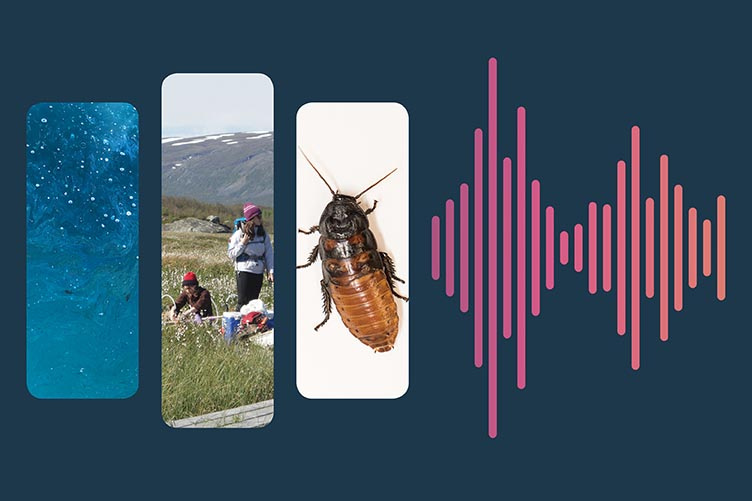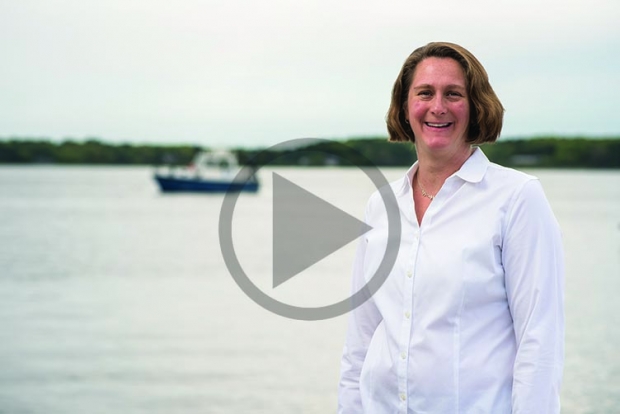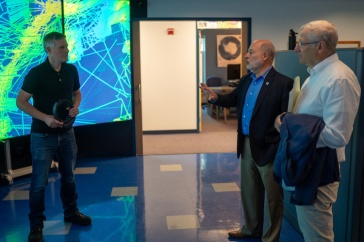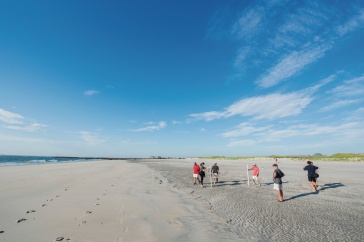
Can you hear that? All around us, in every moment, is an entire world of sound. With acoustic technology, UNH researchers are painting a picture of what is happening on Earth, under its oceans and between some of its smallest creatures. Their findings are helping us better understand topics ranging from how new technologies affect endangered species to how to best mitigate oil spills.

Acoustics provide minimally invasive ways to capture data on the impact of noise on humans and animals. That’s the strategy used by Dan Howard, assistant professor of biological sciences, whose bug-filled lab primarily listens to insects to learn how they communicate and are affected by the noisy world around them.
On a typical morning, Mia Phillips, a master’s degree student studying integrative and organismal biological sciences, is investigating the potential effects of wind turbine-induced noise on American burying beetles, an endangered species, while fellow master’s degree student Sarah Dodgin is weeding through approximately 50,000 one-minute audio files to assess the consequences of prescribed grassland fires to biodiversity.
Listening in the wild provides many opportunities to “monitor the heartbeat of the ecosystem,” Howard says. “Are there changes that coincide with climate change models? What do those changes reflect or signify?”
Michael Palace and Ruth Varner of the department of Earth sciences and the Institute for the Study of Earth, Oceans, and Space are using hydrophones to identify the presence of methane below the water and land surface of the Arctic Circle — critical information for ongoing work in climate change. “Wetlands and lakes are a large, natural source of methane,” says Varner, professor of Earth sciences, explaining hydrophones let them “hear” methane bubbles to learn how often they occur and how much methane is emitted.
“The sensors we fabricate are inexpensive, and this has allowed us to deploy them at many sites and, at these sites, cover the landscape in a way not previously available,” says Palace, an associate professor of environmental science.

It’s important, Varner says, to know how these natural ecosystems are behaving to inform models of methane emissions that will ultimately help predict how this emission pathway may change as the climate does.
At the Center for Coastal and Ocean Mapping, where acoustical research has made possible the detailed maps that give the center world-renowned status, Thomas Weber and Jennifer Miksis-Olds have been back-to-back recipients of the Medwin Prize in Acoustical Oceanography from the Acoustical Society of America.
Weber, an associate professor of mechanical engineering, uses sonar technology to identify methane bubbles in the water column. The importance of this research, he explains, is to gather objective data to inform decisions ranging from how to best mitigate oil spills to addressing climate change. “Most of our planet is ocean. That’s extremely important for things like climate, modeling for weather and daily life,” Weber says.
Weber explains how acoustics provide researchers the chance to “see” below the ocean, “allowing humans to explore its many facets as a habitat, resource, recreational area and even a military battle space.” With acoustics, for example, his team can detect gas bubbles just a few millimeters in radius in 1,500 meters of ocean. “That’s pretty amazing. The scale is just enormous.”
“The oceans are continually changing, and we can use sound to monitor that change — and hopefully to predict change before it happens.”
On more than one occasion, Weber’s research has taken him to the Gulf of Mexico to investigate oil spills. His team, which includes graduate students like Alexandra Padilla, who came to UNH from the University of Puerto Rico to pursue her doctorate under his guidance, is using acoustics to develop methods to help responders understand what is happening beneath the ocean’s surface. “Dispersants are toxic, so you want your response to be measured and accurate,” Weber says. Acoustic research can provide the information to do just that.
The work has long-term implications as well. “Climate is changing. We want to understand the causes and the contributors, and what are the impacts of warming oceans on methane gas bubbles? What is their role in climate change? We need to provide evidence to assess what is happening and to what extent,” Weber says.
For Miksis-Olds, the associate director of research for the School of Marine Science and Ocean Engineering, the “why” behind underwater eavesdropping includes learning about ocean conditions like wind speed and ice cover as well as marine life.
“The ocean is a naturally noisy place with animals, wind, waves and ice,” she explains. “We are examining the question of how human impact comes into play: How does it — or does it — affect marine life?”
Miksis-Olds is lead principal investigator of the Atlantic Deepwater Ecosystem Observatory Network for the U.S. mid- and south Atlantic outer continental shelf, which aims to generate long-term measurements of both natural and human factors in the region. “This is extremely important baseline information as our country considers development in that area for energy resources,” she explains.
Miksis-Olds leads the new Northeast Regional Environmental Acoustics Working Group, which includes Howard and Weber. Funded through UNH’s Collaborative Research Excellence Initiative, the group aims to build interdisciplinary partnerships to address issues related to environmental acoustics.
She sums up the big-picture importance of acoustical research: “We can learn a lot about the environment by listening. We can do a lot of environmental monitoring that will help protect our ocean resources.”
-
Written By:
Jennifer Saunders | Communications and Public Affairs | jennifer.saunders@unh.edu | 603-862-3585




















































